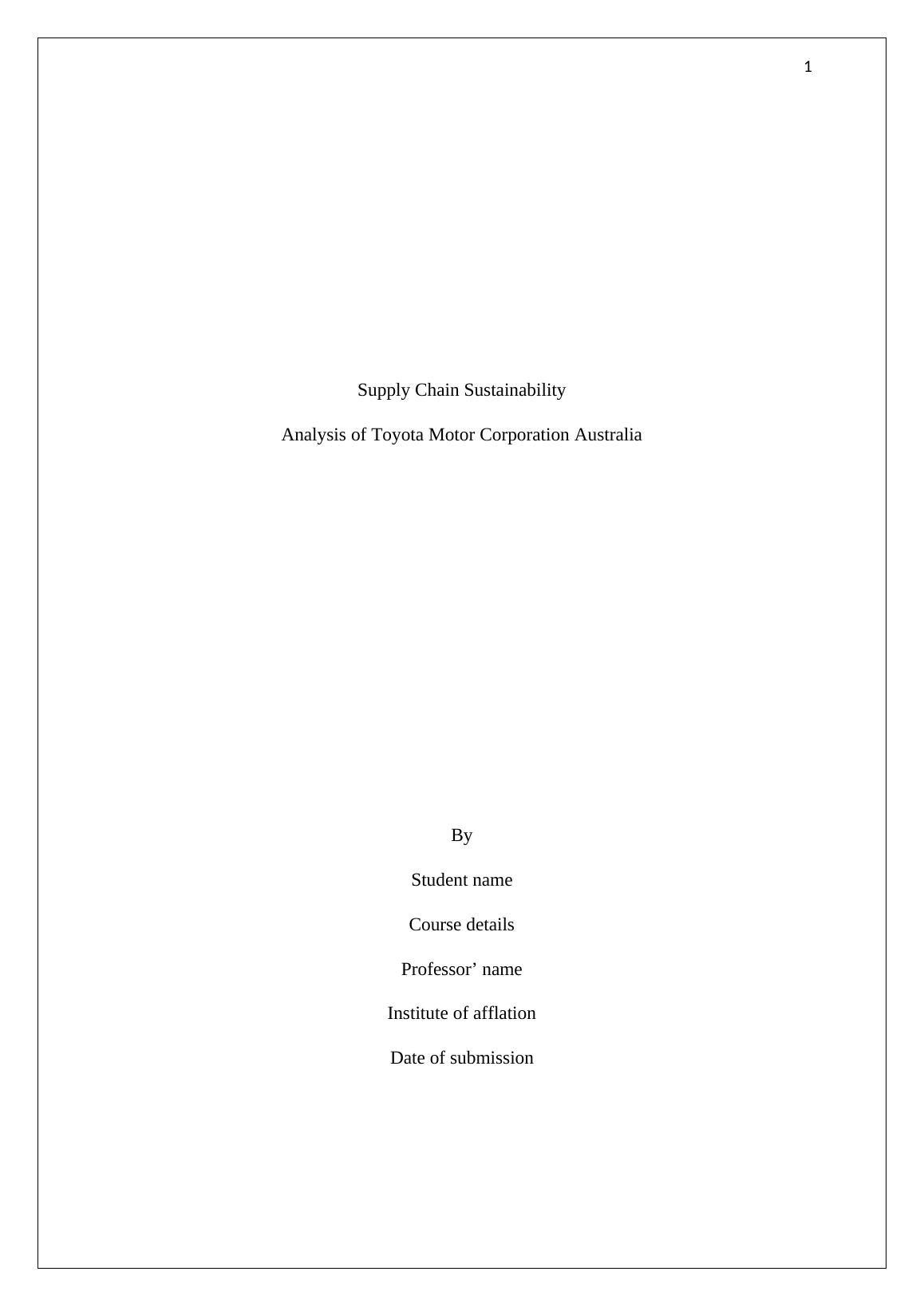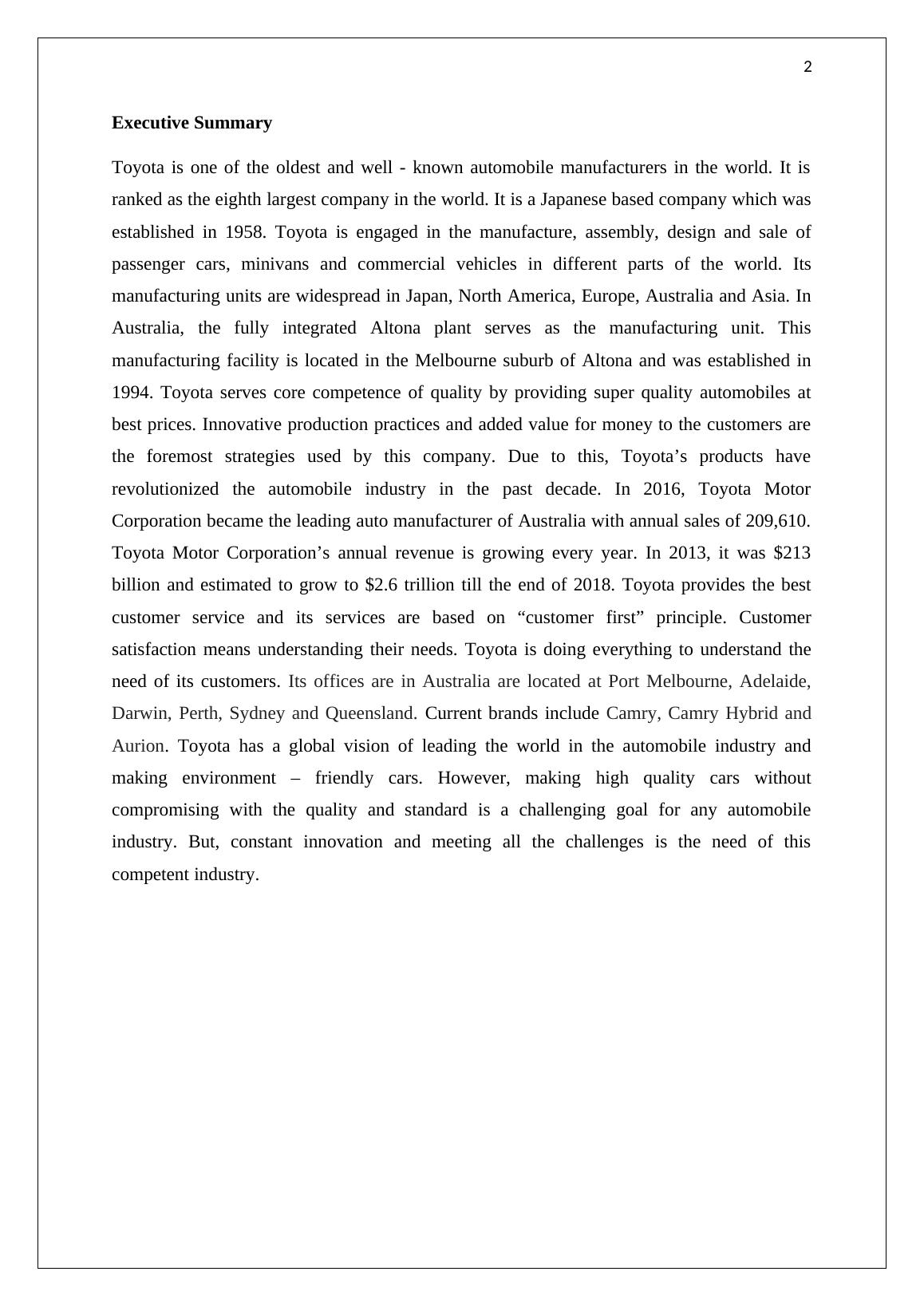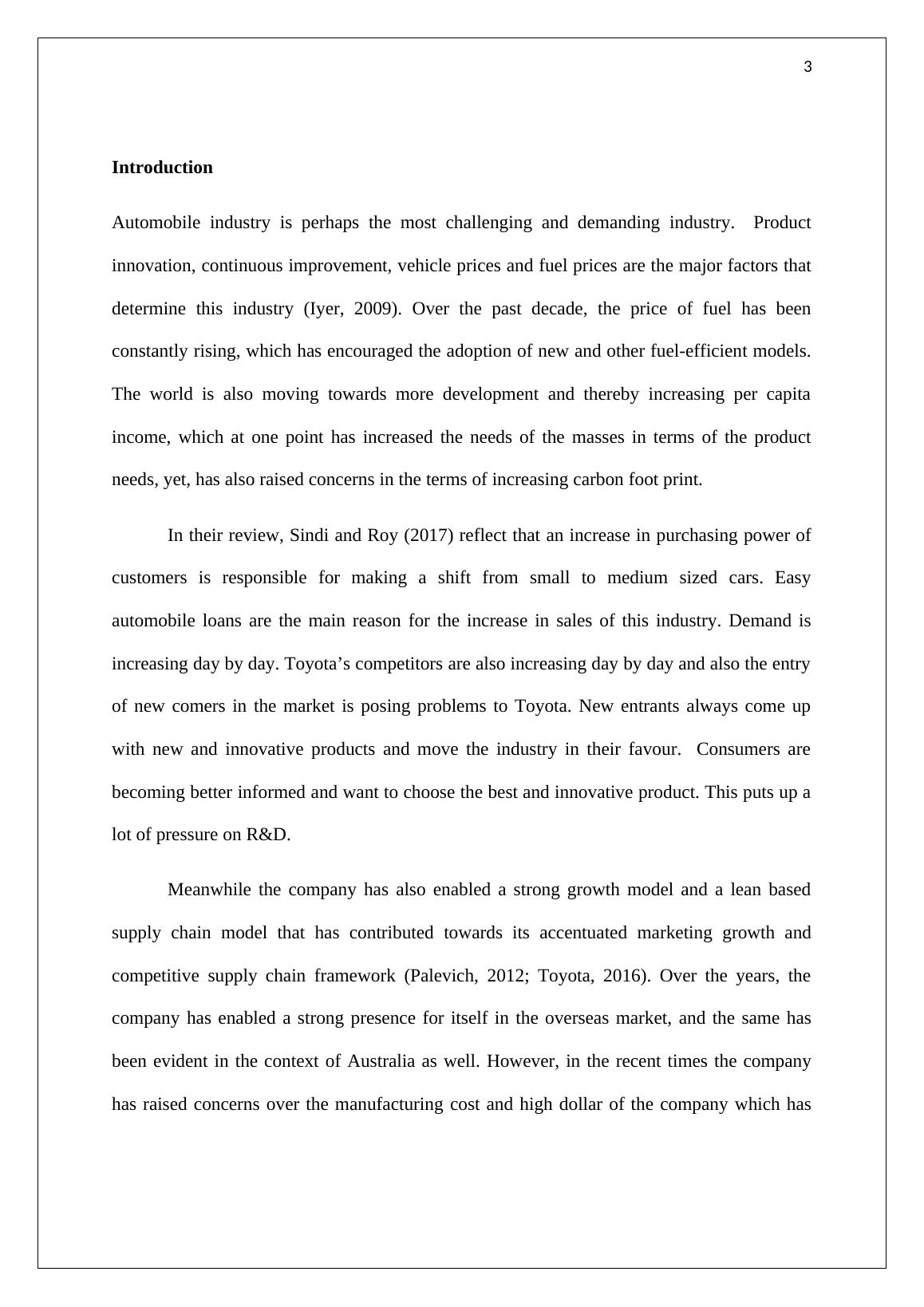MMM267 - Business Logistics Progress - Report
Added on 2020-03-01
15 Pages3936 Words121 Views
1Supply Chain SustainabilityAnalysis of Toyota Motor Corporation Australia ByStudent nameCourse detailsProfessor’ nameInstitute of afflationDate of submission

2Executive SummaryToyota is one of the oldest and well - known automobile manufacturers in the world. It isranked as the eighth largest company in the world. It is a Japanese based company which wasestablished in 1958. Toyota is engaged in the manufacture, assembly, design and sale ofpassenger cars, minivans and commercial vehicles in different parts of the world. Itsmanufacturing units are widespread in Japan, North America, Europe, Australia and Asia. InAustralia, the fully integrated Altona plant serves as the manufacturing unit. Thismanufacturing facility is located in the Melbourne suburb of Altona and was established in1994. Toyota serves core competence of quality by providing super quality automobiles atbest prices. Innovative production practices and added value for money to the customers arethe foremost strategies used by this company. Due to this, Toyota’s products haverevolutionized the automobile industry in the past decade. In 2016, Toyota MotorCorporation became the leading auto manufacturer of Australia with annual sales of 209,610.Toyota Motor Corporation’s annual revenue is growing every year. In 2013, it was $213billion and estimated to grow to $2.6 trillion till the end of 2018. Toyota provides the bestcustomer service and its services are based on “customer first” principle. Customersatisfaction means understanding their needs. Toyota is doing everything to understand theneed of its customers. Its offices are in Australia are located at Port Melbourne, Adelaide,Darwin, Perth, Sydney and Queensland. Current brands include Camry, Camry Hybrid andAurion. Toyota has a global vision of leading the world in the automobile industry andmaking environment – friendly cars. However, making high quality cars withoutcompromising with the quality and standard is a challenging goal for any automobileindustry. But, constant innovation and meeting all the challenges is the need of thiscompetent industry.

3IntroductionAutomobile industry is perhaps the most challenging and demanding industry. Productinnovation, continuous improvement, vehicle prices and fuel prices are the major factors thatdetermine this industry (Iyer, 2009). Over the past decade, the price of fuel has beenconstantly rising, which has encouraged the adoption of new and other fuel-efficient models.The world is also moving towards more development and thereby increasing per capitaincome, which at one point has increased the needs of the masses in terms of the productneeds, yet, has also raised concerns in the terms of increasing carbon foot print.In their review, Sindi and Roy (2017) reflect that an increase in purchasing power ofcustomers is responsible for making a shift from small to medium sized cars. Easyautomobile loans are the main reason for the increase in sales of this industry. Demand isincreasing day by day. Toyota’s competitors are also increasing day by day and also the entryof new comers in the market is posing problems to Toyota. New entrants always come upwith new and innovative products and move the industry in their favour. Consumers arebecoming better informed and want to choose the best and innovative product. This puts up alot of pressure on R&D. Meanwhile the company has also enabled a strong growth model and a lean basedsupply chain model that has contributed towards its accentuated marketing growth andcompetitive supply chain framework (Palevich, 2012; Toyota, 2016). Over the years, thecompany has enabled a strong presence for itself in the overseas market, and the same hasbeen evident in the context of Australia as well. However, in the recent times the companyhas raised concerns over the manufacturing cost and high dollar of the company which has

4contributed towards the challenge in the manufacturing process of the company (Mahler,2007; Wallace and Furgusen, 2014).In these challenges, the company contemplates exist from the market much like Fordand Holden, which are affected by the issues in terms of supply chain and manufacturingbeyond their control (Wallace and Furgusen, 2014). This in turn raises concerns for thecountless stakeholders, employee and general public in terms of sustainability of theoperations, notwithstanding the impact of this exit for the organization (Cetinkaya et al.2011). Through the means of the present review, the state of the supply chain of the companywithin Australia is evaluated, and suggestions from the academic sources, and models ofchain management in other countries for the company are contemplated to providerecommendations for improved stance of the company.Company BackgroundToyota Motor Corporation was established in 1958 in Australia. Initially, assembly ofToyota vehicles in Australia started taking place at the production plant in Port Melbourne,Victoria. This production line was devoted to the Toyota Tiara. In 1978, a new productionplant was established in Altona, Victoria which replaced the old one. In 1986, the first carnamed Toyota Coronawagon was exported and headed to New Zealand. At this time, Toyotastarted manufacturing locally. Till 2006, all manufacturing was shifted to Altona (Dunckley,2014).Toyota was now ready to set a milestone in the automobile industry and launchedmany vehicles including theToyota Tiara, theToyota Corona, theToyota Crown, theToyotaCorolla, the Toyota Camry, theToyota Avalon and theToyota Land Cruiser. In 2010, ToyotaMotor Corporation decided to launch a new car to enter in the new and upcoming hybridindustry. It launched Camry Hybridin 2010 after securing a $35 million subsidy from the

End of preview
Want to access all the pages? Upload your documents or become a member.
Related Documents
Business Report on Toyota Australialg...
|7
|1601
|56
A Case Study of Toyota: HRM Challenges and Recommendationslg...
|12
|2967
|93
The Competitive Strategy of Toyota Motor Corporationlg...
|18
|4722
|147
Cross Industry Analysis of Toyota Corporation's Entry into Chinese Marketlg...
|13
|3633
|132
Business Assignment Operation Managementlg...
|12
|3580
|62
Analysis of the Future of Automobile Manufacturing in China: Assignmentlg...
|5
|1107
|390
